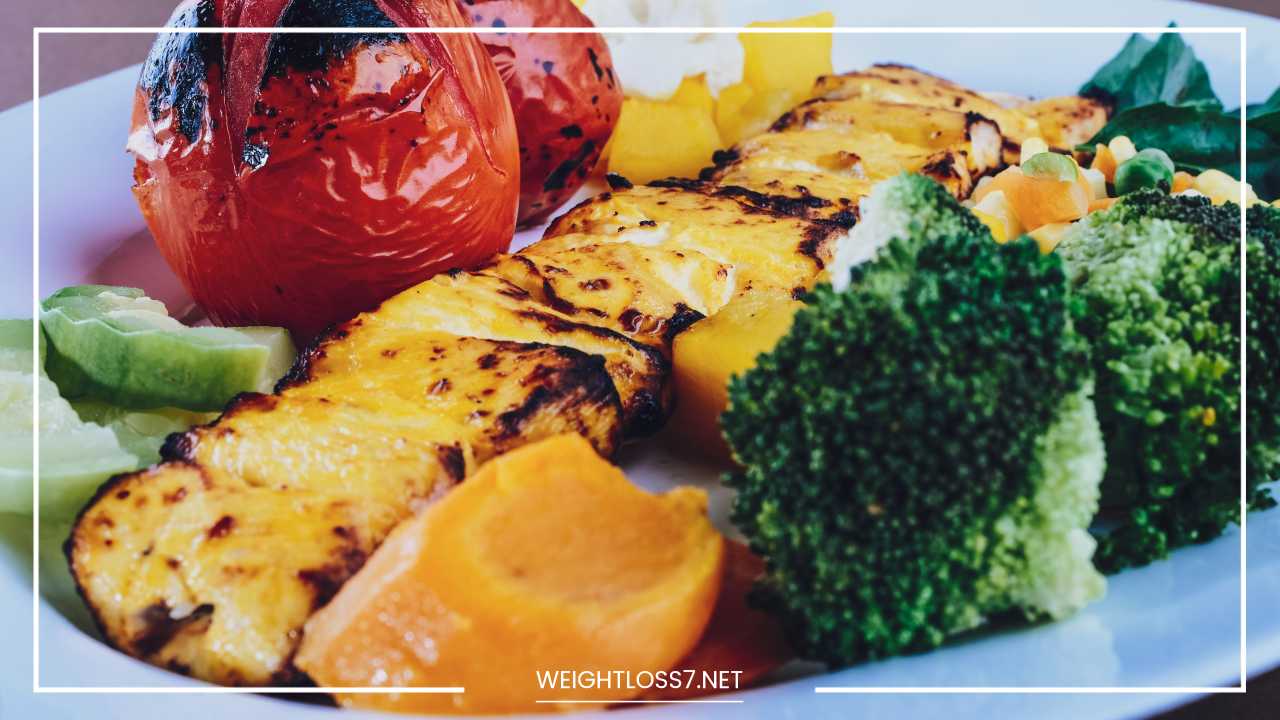The Balanced Diet Blueprint: Eat Well, Live Well

Balanced Diet
The Balancing Act: Your Guide to a Healthy, Personalized Balanced Diet
Forget the struggle of deciphering confusing food trends and restrictive fad diets. The key to fueling your body for optimal health and well-being lies in a simple yet powerful concept: balance.
A balanced diet isn’t about deprivation or chasing the latest superfood trend. It’s about incorporating a variety of nutrient-rich foods from all the essential food groups, giving your body the building blocks it needs to thrive.
This comprehensive guide will delve into the world of balanced diets, exploring why they matter, how to create one that works for you, and the amazing benefits you can reap by prioritizing balanced eating.
Why Balance Matters: Understanding the Building Blocks of Health
Think of your body as a complex machine, needing a constant supply of specific “fuel” to run at its best. From processing information to building muscle, every function relies on a steady stream of nutrients. A balanced diet provides a well-rounded spectrum of these nutrients, including:
- Carbohydrates: The body’s primary source of energy, carbs come in two forms: simple and complex. Simple carbs, found in sugary drinks and processed foods, offer a quick burst of energy followed by a crash. Complex carbs, found in whole grains, fruits, and vegetables, provide sustained energy and are packed with fiber, vitamins, and minerals.
- Protein: Essential for building and repairing tissues, protein is a crucial component of every cell. Lean protein sources like chicken, fish, beans, and lentils provide the amino acids the body needs to function properly.
- Fats: Not all fats are created equal. Healthy fats, found in avocados, nuts, seeds, and fatty fish, play a vital role in hormone regulation, cell growth, and nutrient absorption. Limit unhealthy fats, such as saturated and trans fats, found in processed meats and fried foods.
- Vitamins and Minerals: These micronutrients act as catalysts for many bodily processes, supporting everything from immunity to bone health. A balanced diet ensures you get a variety of vitamins and minerals from different food sources.
Beyond the Basics: Personalized Nutrition for Different Needs
While the importance of balance remains constant, individual needs may differ. Here’s how a balanced diet can be personalized to cater to specific circumstances:
- Age and Activity Level: Growing children need more calories and specific nutrients for development. Athletes require higher protein intake to support muscle recovery. As we age, our dietary needs shift, with a focus on maintaining bone density and gut health.
- Dietary Restrictions: Whether due to allergies, intolerances, or religious beliefs, a balanced diet can be achieved with creative substitutions. Explore alternatives like plant-based proteins for those following a vegetarian or vegan diet.
- Medical Conditions: Balancing your diet with certain medical conditions might involve specific adjustments. For example, managing diabetes may require a focus on low-glycemic index foods to regulate blood sugar levels.
The Benefits of a Balanced Diet: A Feast for Your Body and Mind
The rewards of a balanced diet go far beyond fitting into your favorite jeans. By providing your body with the nutrients it craves, you can experience a multitude of benefits, including:
- Increased Energy Levels: Complex carbs and healthy fats provide sustained energy, keeping you going throughout the day without the dreaded afternoon slump.
- Stronger Immune System: Vitamins, minerals, and antioxidants found in fruits, vegetables, and whole grains help your body fight off illness and infection.
- Improved Weight Management: Balanced diets promote healthy weight management by keeping you feeling full and satisfied, reducing cravings for unhealthy, calorie-dense foods.
- Reduced Risk of Chronic Disease: A balanced diet can help decrease your risk of developing chronic diseases like heart disease, diabetes, and some types of cancer.
- Enhanced Mood and Cognitive Function: Studies have shown that a diet rich in fruits, vegetables, and whole grains can positively impact mood and cognitive function, improving memory, focus, and concentration.
- Improved Gut Health: A balanced diet rich in fiber and fermented foods promotes a healthy gut microbiome, crucial for digestion, immunity, and overall well-being.
Building Your Balanced Plate: A Practical Guide
Now that we’ve established the importance and potential of a balanced diet, how do you translate that knowledge into practical meal planning? Here’s a breakdown of how to create a balanced plate that suits your individual needs:
1. Fruits and Vegetables (Aim for at least 5 servings daily):
- Variety is key: Choose a rainbow of colors to ensure you’re getting a wide range of vitamins, minerals, and antioxidants.
- Incorporate fresh, frozen, and canned options: Frozen and canned fruits and vegetables can be just as beneficial as fresh and offer convenience. Opt for options packed in water or light juice instead of heavy syrup.
- Think beyond the plate: Sneak in extra servings with fruit smoothies, veggie-packed soups, or roasted vegetables as a snack.
2. Whole Grains (Make half your grains whole grains):
- Swap refined for whole: Choose brown rice over white rice, quinoa over couscous, and whole-wheat bread over white bread.
- Explore ancient grains: Consider incorporating ancient grains like barley, farro, and oats into your diet for added variety and a unique nutritional profile.
- Check the label: Look for “whole wheat” or “whole grain” listed as the first ingredient on food labels.
3. Lean Protein (Include a moderate serving in every meal or snack):
- Variety matters: Rotate different protein sources throughout the week to ensure you’re getting a complete range of amino acids.
- Go beyond meat: Explore plant-based protein options like beans, lentils, tofu, tempeh, and nuts. Fatty fish like salmon and tuna are excellent sources of omega-3 fatty acids.
- Lean preparation methods: Opt for grilling, baking, or poaching to minimize added fat and calories.
4. Healthy Fats (Don’t shy away from healthy fats):
- Incorporate healthy fats daily: Include a source of healthy fats like avocado, nuts, seeds, or olive oil in your meals.
- Moderation is key: While healthy fats are essential, limit the amount you consume, as they are still calorie-dense.
- Healthy fat swaps: Use avocado instead of butter on toast or drizzle olive oil over vegetables instead of creamy salad dressings.
5. Dairy or Dairy Alternatives (Choose low-fat or fortified options):
- Calcium for strong bones: Dairy products like milk, yogurt, and cheese are good sources of calcium, essential for bone health.
- Fortified plant-based alternatives: If you follow a dairy-free diet, opt for fortified plant-based milks and yogurts enriched with calcium and vitamin D.
- Lactose intolerance? Explore lactose-free dairy options or consider yogurt, as the fermentation process often breaks down lactose.
Beyond the Plate: Essential Tips for a Balanced Lifestyle
Creating a balanced diet goes beyond just the foods you choose. Here are some additional tips to consider:
- Planning is key: Taking the time to plan your meals for the week can help you make healthy choices and avoid unhealthy last-minute options. Utilize meal prepping strategies to save time and avoid unhealthy temptations.
- Read food labels: Don’t be fooled by marketing claims. Pay attention to serving sizes and nutrient content when reading food labels. Opt for foods lower in saturated and trans fats, added sugar, and sodium.
- Cook more at home: Cooking at home allows you to control the ingredients and portion sizes of your meals. Experiment with new recipes to keep things interesting and explore different cuisines.
- Make healthy swaps: There are plenty of ways to make healthy swaps in your favorite recipes. Use brown rice instead of white rice, try baked chicken instead of fried, or add avocado slices to your burger instead of cheese.
- Don’t deprive yourself: Occasional indulgences are perfectly fine. The key is to focus on balance and moderation in your overall diet. Allow yourself treats in moderation, but prioritize healthy choices most of the time.
- Stay hydrated: Water is essential for overall health. Aim to drink eight glasses of water daily to support digestion, regulate body temperature, and keep you feeling full.
Building a Balanced Relationship with Food: A Journey, Not a Destination
Remember, a balanced diet is a journey, not a destination. There will be times when you slip up or indulge.
The important thing is to get back on track and focus on making healthy choices most of the time. Here are some additional pointers to foster a positive relationship with food:
- Practice mindful eating: Pay attention to hunger and fullness cues. Eat slowly, savoring each bite, and stop eating when you’re comfortably full, not stuffed.
- Focus on the positive: Think about how healthy eating makes you feel – energized, focused, and strong – rather than depriving yourself of your favorite foods.
- Celebrate non-scale victories: Focus on how your body feels and the improvements in your energy levels and overall well-being rather than just the numbers on the scale.
- Seek support: Surround yourself with people who support your healthy lifestyle choices. Consider consulting a registered dietitian for personalized guidance.
By incorporating these principles and creating a balanced diet that works for you, you’ll be well on your way to fueling your body for optimal health and well-being, allowing you to live a vibrant and fulfilling life.
Expanding Your Balanced Diet Horizons: Exploring Culinary Adventures
A balanced diet doesn’t have to be bland or monotonous. There’s a whole world of culinary delights waiting to be explored, all while adhering to the principles of balance and variety. Here are some tips to add flavor and excitement to your balanced eating journey:
- Embrace Global Flavors: Step outside your comfort zone and explore cuisines from around the world. Indian curries packed with vegetables and lentils, Thai stir-fries bursting with fresh herbs, or Mediterranean dishes rich in olive oil and seafood are just a few examples. Experiment with different spices and herbs to add depth and complexity to your meals.
- Seasonal Produce is Key: Take advantage of the freshest, most flavorful fruits and vegetables available by incorporating seasonal produce into your meals. Farmer’s markets are a great way to discover local, seasonal bounty. Roasting seasonal vegetables brings out their natural sweetness, making them a delicious and nutritious side dish.
- Get Creative with Cooking Techniques: Don’t get stuck in a rut with the same old cooking methods. Explore different techniques like grilling, poaching, steaming, and stir-frying to unlock new flavor profiles and textures in your food.
- Healthy Doesn’t Have to Be Bland: There are plenty of ways to add flavor to your meals without resorting to unhealthy additives. Use fresh herbs and spices liberally, experiment with citrus zest, or try marinades to infuse your protein with flavor.
- Make it Fun!: Cooking doesn’t have to be a chore. Put on some music, get creative in the kitchen, and involve family or friends in the cooking process. This can turn meal preparation into a fun and social activity.
Beyond the Plate: A Balanced Lifestyle for Overall Well-Being
Remember, a balanced diet is just one piece of the puzzle when it comes to overall well-being. Here are some additional lifestyle factors to consider for a holistic approach:
- Regular Exercise: Physical activity is crucial for maintaining a healthy weight, boosting energy levels, and improving overall health. Aim for at least 150 minutes of moderate-intensity exercise or 75 minutes of vigorous-intensity exercise per week. Find activities you enjoy, whether it’s brisk walking, dancing, swimming, or team sports.
- Quality Sleep: Getting enough quality sleep is essential for physical and mental health. Most adults require 7-8 hours of sleep per night. Establish a regular sleep schedule, create a relaxing bedtime routine, and prioritize a sleep-conducive environment.
- Stress Management: Chronic stress can wreak havoc on your health. Practice relaxation techniques like deep breathing, meditation, or yoga to manage stress effectively.
- Mindful Eating: Pay attention to your hunger and fullness cues. Eat slowly and savor your food, avoiding distractions like screens while eating.
Final Word: Your Balanced Diet Journey Begins Today
Creating a balanced diet is an investment in your health and well-being. By incorporating the tips and strategies outlined in this guide, you’ll be well on your way to fueling your body for optimal performance and living a vibrant life.
Remember, it’s a journey, not a destination. Focus on progress, not perfection, and celebrate your victories along the way.
Enjoy exploring the world of healthy, delicious food, and embrace the positive changes a balanced diet can bring to your life.

















